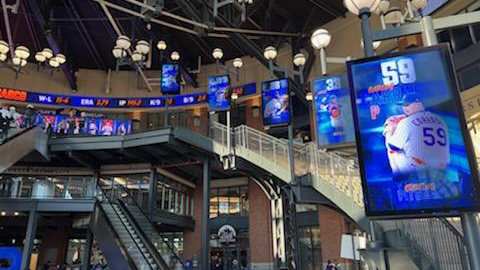Stadium design philosophy has long been a case of "bigger is better," with professional and college teams alike playing a game of one-upmanship when it comes to increasing capacity. But cramming in as many general admission seats as possible is no longer what makes a venue outstanding—or profitable for its owners.
The competition for capacity has shifted to a competition for enhanced venue experiences, upgrading the traditional sit-and-stay model of general admission.
With fans demanding more from live events, providing a fun, engaging experience is key to attracting attendees—and a contributing factor in whether they return. And every experience is an opportunity for the venue to boost revenue.
These experiences might feature bespoke fan-interactive brand activation, in-game entertainment, VIP hospitality, lounges and clubs, comfier and wider seating, exclusive access to food and beverage options, in-seat ordering, fan zones, pre and post-game gatherings, or high-end audio and visual technologies.
Creating Tiers of Premium Venue Experiences
The entire concept of a premium experience is being redefined in today's stadium, which has evolved from the old "corporate" offering of expensive, one-dimensional suites (which were limited in number). Now, multitiered options are available to all visitors. Throughout a venue there are a multitude of ways to deliver premium experiences that increase customer spending.
With the majority of ticket holders being general admission, venues now encourage fans to arrive early and stay late to socialize at stadium bars, restaurants, or designated fan zones, both inside and outside the building. Large, high-definition LED displays—installed wall-to-wall in these spaces—entertain fans with live sports broadcasts, fantasy scores, and sponsor messages. The longer guests stay, the more likely they are to purchase food, beverages, and memorabilia.
As a focal point in social areas, LED displays are an ideal way for stadium operators to keep fans in the know. Besides venue information, on-screen content can also be tailored to promote special deals, advertise team stores or other food and beverage options around the stadium. And they're a great opportunity for brand sponsors to reach a targeted audience.
Citi Field, home of the New York Mets, recently added over 300 Samsung screens throughout the concourse and suites, which provide 100 channels of sports and entertainment content. Another 1,000 Samsung screens are scheduled to be installed and deployed in 2023. These displays upgrade the static experience to a dynamic one while creating more opportunities to sell ad time to sponsors.
At SoFi Stadium in Los Angeles, CA, a first-of-its-kind indoor-outdoor building design breaks away from the traditional model of confining fans within the venue for the duration of the event. SoFi Stadium's open-sided design encourages visitors to roam so they can explore the different experiences located around the venue. Thanks to a combination of Samsung's 360-degree, dual-sided Infinity Screen—the world's biggest stadium screen—and clever sightline architecture, fans don't have to wait until a break in the game to grab a snack or drink. They can still see the on-field action on the display while they walk the open concourses.
Now, general admission ticketholders get to enjoy a premium experience, too, which they'll return to to enjoy again.
VIP Hospitality and Beyond
For most modern stadiums, the largest chunk of revenue comes from the smallest section of seats. Suites and boxes may be a tiny percentage of the overall capacity, but VIP hospitality is big business. Displays play an important role in the luxury suite experience. Outside the suite, digital signage provides a clearer and more high-end way of addressing a room. And inside the suite, screens can display personalized welcome messages, as well as targeted brand content. In-suite HD displays allow visitors to host business events while freely enjoying the VIP environment—and staying connected to the game. VIP guests enjoy large sofas, in-suite bars, and access to exclusive camera angles of the field, complemented by powerful audio.
Exclusive clubs and lounges are another tier that entices guests to buy a once-in-a-lifetime experience. Tunnel clubs—where fans can get up close to players as they exit and leave the locker room—post-game player visits, end zone nightclubs, and cabanas or on-field terraces are just a few examples. Integrated technology in these areas can make visitors feel even more special—with individual screens on seats, such as those at Hard Rock Stadium in Miami, or private parties where they have their own designated screens to enjoy.
Major League Soccer is also flying the flag for inventive premium VIP experiences. As the league expands, new and established teams alike are focused on creating exciting venues that are comfortable and sociable. VIP suites provide access to exclusive catering, and for even more fun, sponsors such as drink companies provide special offers—like free drinks or discounted items—that are activated when the team scores.
For premium venue experiences, the ceiling is as high as the operator's creativity. At professional and collegiate stadiums alike, demand for these enhanced experiences is growing. Complemented by the latest displays and connected venue technology, premium event experiences battle the convenience of the couch—and offer a more sociable, shareable game day that can't be found anywhere else. Visitors are ultimately happy to buy a ticket to be a part of it.
Find out more about how you can leverage fan data to drive the next generation of live events and audience engagement in this free guide. And discover specific LED signage solutions for live events and sports that can help you redefine the venue experience—delivering the convenience fans want and the moments that will keep them coming back for more.
